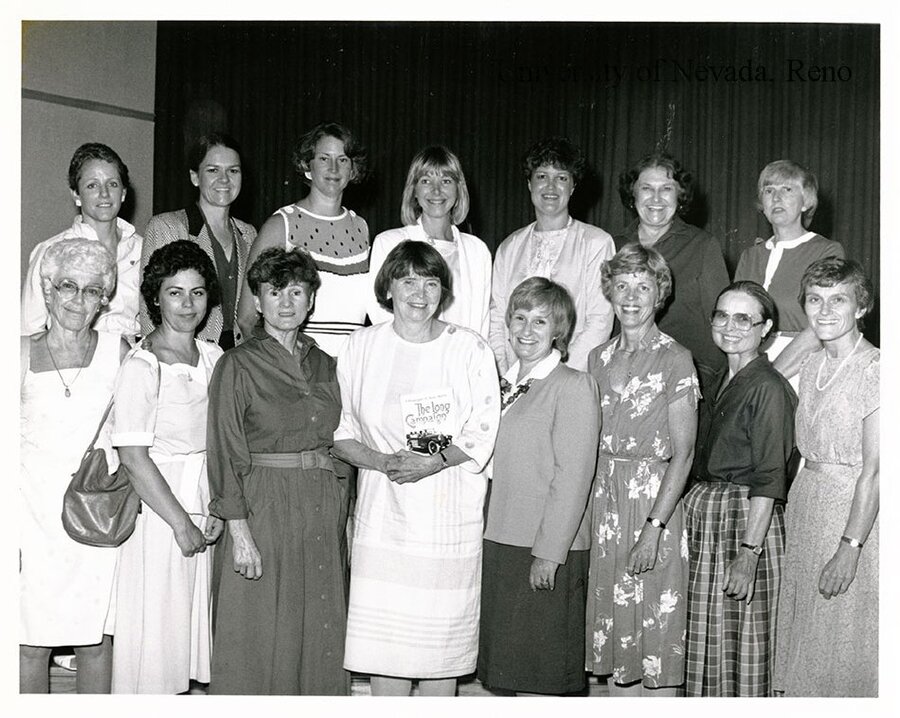All of the successful movements in history begin with memorable words. For Women’s Studies at the University, it started with a letter from English Professor Anne Howard to N. Edd Miller, president of the University.
Howard’s letter, sent to Miller in 1973 as part of Howard’s work as chair of the President’s Ad Hoc Committee on Women’s Studies, is chronicled in the 1994 paper, “Defining Moments in Women’s Studies at the University of Nevada, Reno,” by Sheryl Kleinendorst and Jean Ford.
They write that the letter’s purpose was to secure funding for a Women’s Studies Program by 1974.
“We present the documents for your consideration in the hope that this report may be the first step in the realization of a Women’s Studies Program at UNR,” wrote Howard, who had joined the faculty of the Department of English in 1963. When she was hired, Howard was the only fulltime female professor in the Department of English.
As was typical for any work that Anne Howard was involved with, it wasn’t merely words that she shared. Significant data had been gathered and much groundwork had already been laid.
According to Kleinendorst and Ford, the committee’s report included survey results focused on possible courses, student preferences for courses, and a survey detailing universities of similar sizes and scope where Women’s Studies programs were already in place.
Howard’s letter included the news that several departments – Political Science, English, Sociology, Social Services and Corrections, Anthropology and Art – were already offering courses in the subject matter or were planning on adding courses soon. The near-term goal was to offer a foundational course, Women’s Studies 101, and within three years offer Women’s Studies as a minor.
Howard added in her letter that, “We have tried to be realistic in our requests, taking into account the University’s eternal shortage of money for new programs, but recognizing the real need for developing women’s programs.”
The goal, thoughtfully presented and underpinned with data that demonstrated a clear need, wasn’t to be achieved by 1974. Or even, really, within the next five years.
It turned out to be a much longer campaign -- something Anne Howard knew a little bit about.
"I felt I wasn't serving a purpose"
ANNE HOWARD HAD ORIGINALLY WANTED to be a journalist.
She had grown up around reading and education. Her mother was a grade school teacher. In high school, she’d worked as a proofreader at the newspaper in Albuquerque, New Mexico, making 85 cents per hour. After she’d graduated from the University of New Mexico in 1949, she was society editor at the Albuquerque newspaper, then moved with her husband, William Howard, who was an artist, to Mexico City where she worked on the staff of an English-language newspaper.
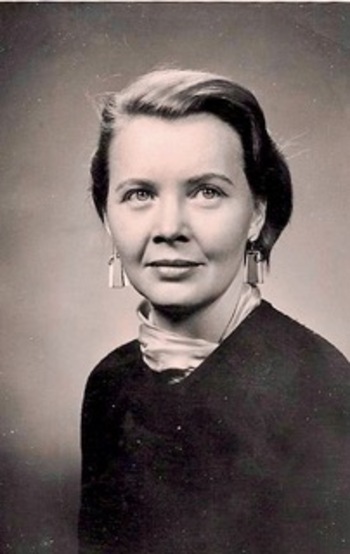
In a 1985 interview, she confided that although she enjoyed the writing and reporting involved with journalism, “I felt I wasn’t serving a purpose in journalism.” When she and Bill returned to New Mexico, she taught high school English and liked it. “So I went back to school to get my doctorate,” she said. She and Bill also had a family – son Jason and daughter Emily. Their household was predicated on the arts, on learning, respecting others and standing up against discriminatory behavior.
“I learned early on from my mother that you don’t take things lying down,” remembers Jason, an English teacher, drama coach and education consultant who lives in Connecticut.
Anne Howard taught and directed the remedial English program at the University of New Mexico before both she and Bill joined the University of Nevada faculty in 1963, Bill in the Department of Art and Anne in the Department of English.
Bill grew up in Washington, D.C. He spent long hours in the museums there. As an officer in the Engineer Corps during World War II, he learned drafting. He had met Anne at the University of New Mexico and throughout their life together – he died in 1986 – he encouraged her career path.
Anne joined a Department of English which at the time included several professors of national reputation. Robert Gorrell, who had helped hire Howard, had been author, along with Charlton Laird, of the “Modern English Handbook,” one the bestselling English textbooks of all-time, used in university and college classrooms throughout the country. Walter Van Tilburg Clark, author of the classic novel, “The Ox-Bow Incident,” was a popular instructor.
The department, along with two others, was housed in Frandsen Humanities. Frandsen at that time was indicative in some ways of the entire University. Although it was the 1960s, and the building was striving for modernity, it still harkened to an earlier time. Rough edges still abounded. Howard wrote about this in the 2005 Winter issue of “Footprints,” the Historic Reno Preservation Society’s newsletter.
“Even the furniture spoke of previous times,” Howard wrote of Frandsen, which was named in honor of 1895 graduate and Biology Professor Peter Frandsen. The building had been primarily focused on agriculture-related education and activities when first opened in 1918. “Large library desks had migrated from the Clark Administration building which had served once as a library … In the basement rooms, steel plates still covered the one-time blood gutters (from animals who were killed when the building served for a time as a slaughterhouse) and offered commodious accommodations for rats.”
She added in her essay: “The atmosphere was very male. Upstairs in Foreign Languages, a few women taught; downstairs, only emergency fill-ins were women – ‘housewife help’ in Dr. Robert Gorrell’s term. I found it hard to believe I was the only regular staff member who was a female in a discipline that granted a healthy portion of its doctorates to women. By 1970, the department doubled its female faculty by hiring a second woman, Ann Ronald, confusing many a student, since by that time first names became acceptable practice when addressing faculty.”
Looking back now, at age 93 and living in Connecticut with Jason and his wife, Howard said the University in those early days reflected what was happening in the state and throughout the country. There were subtle changes occurring, even if many of them were obscured by the firm grip of the status quo.
She had been optimistic that her letter to Miller, the University’s 11th president who served from 1965-73, might forge some sort of meaningful change. That it didn’t – Miller was soon to leave to campus to become president at the University of Maine at Portland-Gorham and also the timing for the proposal was deemed by the administration to not be right – didn’t deter her.
“I learned very early on that it could be very complicated to go around things in order to get things done,” she says today. “You had to go to people who were very influential on campus. We had some good presidents … some who were supportive and some who were not as supportive. You just had to work a little harder in order to get things done.
“(Miller) was friendly about it … he was pretty good about it even if he didn’t do anything with it. But we didn’t have to go to the president. What made a difference was having deans … having a dean who was supportive. If you had a dean who was supportive, you could get things done.”
Over the next few years, Howard, as she continued her teaching and writing, remained active with important committee work, much of it integral to the advancement of women’s issues on campus. She was a member of the University Women’s Caucus. She chaired the Women’s Intercollegiate Athletic Board, which fought to narrow the inequalities that existed between the athletic programs for male and female athletes at the University in the early to mid-1970s.
Whenever there was an opportunity to shed light on why awareness of such inequality was needed, Howard took it.
Her letter to the editor published in the Reno Evening Gazette on Aug. 25, 1976, was just one example. Luella Lilly was a groundbreaking figure on the campus, serving as a coach and a women’s athletics administrator from 1969-76. Due to a lack of administrative support, Lilly was soon to leave the University for UC-Berkeley.
Howard had worked closely with Lilly throughout Lilly’s time on campus. She was impressed by Lilly’s thoughtfulness, her professional and personal courage, the advancements Lilly – known as “Lu” to her friends, colleagues and athletes – had made on behalf of female Wolf Pack athletes in the face of a miniscule budget.
The University was losing a proven leader. Howard was frustrated by the development.
“When Dr. Luella Lilly leaves the University of Nevada at Reno next month to become Director of Women’s Athletics at the University of California at Berkeley, many Nevada women who have had the privilege of working with her will both regret her departure and applaud the sense of the distinguished university in hiring her,” Howard wrote. “In spite of minimal financial support, constant frustration in implementing changes and an administrative decision that essentially dissolved her job in May of 1975, Dr. Lilly has maintained a steady devotion to a program that was finally submerged last year.”
What Howard and others on the campus were facing in the fight to establish Women’s Studies was also being experienced on college campuses throughout the country.
It was, says Debra Moddelmog, dean of the College of Liberal Arts who as an undergraduate at Georgia Southern College during the mid-1970s was among a growing number of young women attending college who were wondering why there weren’t more female narratives, perspectives and history being shared in their classrooms, a needed and natural progression for higher education in America.
“Women’s Studies programs across the U.S. started not simply as consciousness-raising opportunities but as an institutional home for faculty and students who wanted to pursue feminist approaches that placed women’s lives and the harmful effects of systems of privilege and oppression at the center of academic study and activism,” she says. “Over time, these programs have evolved to incorporate more sustained investigations of gender, race, ethnicity, class, sexuality, nationality, disability, and religion, and their intersectional dynamics in an effort to confront the very structures of power that prevent us from attaining a level playing field within U.S. society.”
"She'd done a very good job preparing"
ALTHOUGH LOSING TALENTED INDIVIDUALS LIKE Lu Lilly made the road to Women’s Studies more difficult, there were developments in new administrative leadership that helped. In February 1977 Rebecca Stafford, the chair of the Department of Sociology, was named dean of the College of Arts and Science.
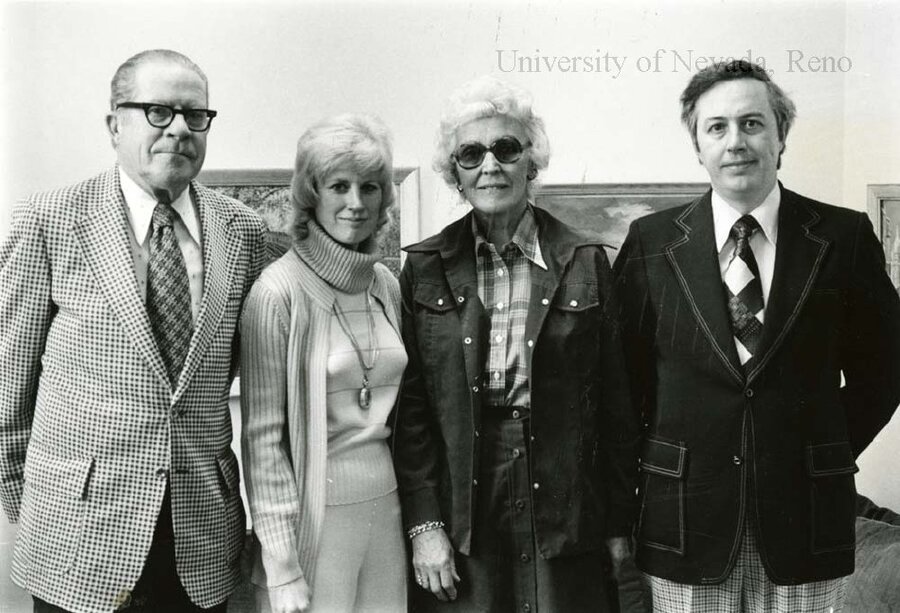
Although Stafford’s appointment was historic – she was the institution’s first female appointed dean of a college other than the traditionally female colleges of Nursing and Home Economics – her selection also was a vivid example of the forces female faculty faced as they worked to gain traction on campus.
Stafford’s resume and accomplishments were impeccable. Growing up in Topeka, Kansas, she edited her high school’s newspaper, was on the debate team, and worked nights at the Topeka newspaper writing obituaries. She was a 1958 graduate of Radcliffe College, and had received her M.A. and Ph.D. in Sociology at Harvard. She was a rising scholar in the field of marriage and family relationships.
Robert Gorrell, who by then was academic vice president for the University and was advising President Max Milam on the Arts and Science dean selection, remembered in a 1983 University Oral History what happened next:
“There was quite a lot of controversy over choosing Becky Stafford dean of Arts and Science. Becky had been chairman of Sociology while I was dean of Arts and Science, and I thought a very good chairman and a very good administrator. … And on the basis of the national search, the (search) committee did come up with two candidates – Becky and a man. The Arts and Science chairmen very strongly recommended the man rather than Becky, and in talking with the Arts and Science chairmen, it was apparent that quite a lot of it was not wanting a woman dean.”
Gorrell, who was a faculty member and administrator at the University from 1945-1980, remembered that such thought wasn’t uncommon on campus at the time.
“Well, I can remember a couple of instances; I remember one department chairman pounding the table and saying there would be no women in his department and he’d see to it and there weren’t,” he said. “They didn’t think they could work with a woman dean.”
Gorrell and Milam both knew Stafford. They respected her highly. They knew there was little doubt she would make an excellent dean.
In a 1978 Oral History, Milam recalled that Stafford had done an outstanding job during the interview process.
“And I was impressed,” he said. “She’d done a very good job preparing.”
Both Milam and Gorrell agreed that Stafford was the best choice. She was appointed dean.
“I think a large part of it is just plain old male chauvinism by some of the department chairmen that just can’t see themselves working for a female dean,” Milam, who served as the University’s 12th president from 1974-78, said. “I’m not going to name names, but I think there was some element of that in the reaction.”
Stafford, as she demonstrated throughout a distinguished career in higher education that would include serving as president of three different universities until her retirement at president of Monmouth University in New Jersey in 2003, proved to be progressive, ambitious and effective. Stafford organized an advisory board for the college, which included several prominent northern Nevadans. In an April 1977 interview, she said her priorities for the college included growing honors programs, implementing more interdisciplinary courses “which are issue-oriented,” and developing more faculty interest in the newly developed interdisciplinary courses.
“The dean is the spokesman for the faculty,” Stafford said. “I don’t make decisions in a vacuum but work with others.” Stafford, who was also a dog lover and who ran 2 ½ miles each day with her dogs, was also driven. “I also see myself as a sheepdog barking at the faculty’s heels,” she added.
With “issue-oriented” and “interdisciplinary” among the College of Arts and Science’s watchwords, Women’s Studies was approved as an interdisciplinary program in 1978. The University offered what is credited as being the first official Women’s Studies course during the fall 1979 semester: Women’s Studies 101: Introduction to Women’s Studies.
“Eventually we ended up with women who were deans,” Howard remembers today. “You knew when that happened, we were going to be able to offer courses, and eventually to have the head of Women’s Studies be an actual position. We had very little budget. But that didn’t matter so much. We would adjust things and make them fit.”
Women’s Studies 101 in fall 1979 was as interdisciplinary as a course could be. It was taught by five instructors, including Anne Howard and Rebecca Stafford, as well as Frank Hartigan of History, Amal Kawar of Political Science and Larry Larsen of Business. The course combined history with contemporary and future issues women faced. The five instructors each had volunteered to teach the course.
In a 1979 interview that fall, Howard, who taught the language portion of the course, said, “In a way, it’s an effort to remedy the omissions of the past. …. I think women need to be informed about their own past and their own characters.”
Twenty-five students, all women, were enrolled in the class that semester. But, Howard added, “If a man wants to minor in women’s studies, we’re perfectly happy to have him.”
"English Professor Anne Howard got it started"
THERE WAS MORE GROWTH IN WOMEN’S STUDIES over the next several years.
The Women’s Studies Board brought Congresswoman Bella Abzug of New York, one of the nation’s leading voices for the passage of the Equal Rights Amendment, to campus. A then-somewhat unknown comedian named Whoopi Goldberg was later brought in to help raise funds for Women’s Studies.
“We needed money and we got Whoopi Goldberg,” Howard remembers. “We had Bella Abzug who came to campus. They usually didn’t want much money to come to campus for us. We would hire them if they were willing to get $100 and were willing to put up with a casino hotel room.”
During 1985-86, the program received funding for a Director of the Women’s Studies Program. Elaine Enarson, a sociologist who had done her studies at UC-Santa Cruz as well as the University of Oregon, was hired as the first director.
In October 1986, the small white house on Virginia Street across from the Jot Travis Student Union, which since 1980 had served as the University’s Women’s Center, celebrated the installation of Enarson and her staff of three – two student positions and a graduate student.
The home had been discovered by three University women – Howard, Dean of Student Services Roberta Barnes and Tey Diana Rebolledo, an instructor and a foundational voice in Chicano/a/x literary criticism.
“We wanted a place for returning women students and a focus on women’s events,” Howard said in a 1986 interview. “But there was a family there. A husband, wife and two Dobermans.”
Eventually, with the help of President Joe Crowley, the home became home to the Women’s Center. University expansion eventually necessitated the home being torn down, with the Women’s Center relocating to one of the old Victorians on Center Street.
Enarson, in a 1986 interview, felt the time was right for the program.
“There’s a future here,” she said. “I have a missionary spirit. … There’s a real need in this community for women’s issues to be publicly addressed.”
By 1997, the University was offering Women’s Studies as a major. Another female dean of the College of Arts and Science, Ann Ronald, like Rebecca Stafford before her, was one of the key players.
Ronald had grown up in Seattle, Washington. A lover of the outdoors, she stayed in Washington for her undergraduate education, earning her degree in English from Whitman College in Walla Walla in 1961 (coincidentally also the alma mater of Jason Howard, Anne Howard’s son). She earned her graduate degrees from the University of Colorado and Northwestern. As Howard wryly noted, Ann Ronald’s hiring in 1970 doubled the number of female professors in the University’s Department of English.
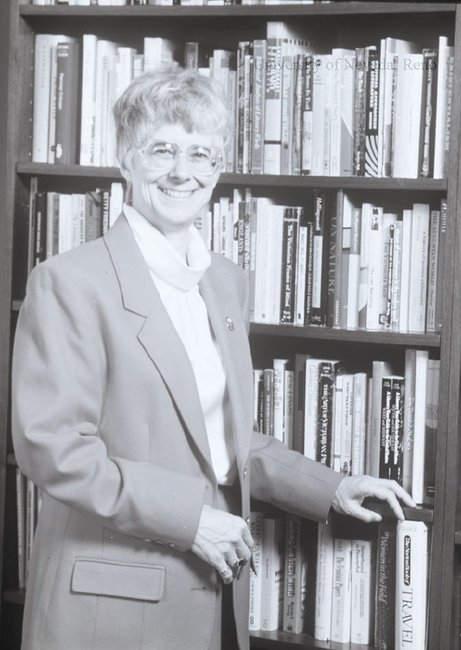
An accomplished and nationally recognized writer – Ronald is a 2006 Nevada Writers Hall of Fame inductee – she also was considered one of the University’s finest instructors, teaching American and British Literature and Nature Writing. Ronald directed the Department’s Graduate Studies Program and chaired the Department of English, and was Acting Dean of the Graduate School. She was appointed dean of the College of Arts and Science in April 1989. President Joe Crowley said of Ronald’s appointment, “Ann has been a leader among our faculty for many years … and is an excellent choice for this critical position.”
Among Ronald’s many accomplishments as dean included the recruitment and addition of a cadre of young professors who helped build the department and program strengths of her college. Just one example was the hiring of the young English professors who helped to quickly turn the University into a nationally recognized powerhouse in Environmental Literature and Ecocriticism. It wasn’t surprising, then, that the search for talent extended into other areas of scholarship as well, including Women’s Studies, with the appointment of Jennifer Ring as director in 1996. Ring had designed the first two courses in Women and Politics and Feminist Theory in the Department of Political Science at UC-Berkeley and also forged a nationally-recognized reputation for her writing and scholarship, which examined topical issues such as gender roles and inequalities in athletics.
In a May 1997 interview, Ring described the new Women’s Studies major as “needed.”
“The major explores issues that are absolutely crucial,” she said. “It’s a force that shifts perspectives. Maybe someday all major courses of study will be like that and Women’s Studies won’t be unique. But for now, it’s needed.”
Ring was asked what took so long for Women’s Studies to become an academic major at the University.
“English Professor Anne Howard got it started, and Ann Ronald, former dean of Arts and Sciences, made it a priority,” Ring said. “My feeling is that the campus has really been on the move since 1989 or so and has made a commitment to being among the top small universities … The major provides an option for our students to gain an in-depth understanding of women in historical and contemporary contexts. It will have a positive influence on the University.”
"One of the most vital academic centers at our university"
IT TOOK ALMOST 25 YEARS, but what began with a letter to a president and led to a major was the work of not one woman, but many, Anne Howard says today.
“Oh heavens no, it was many of us,” says Howard, who retired in 2000. Among her many University awards is the F. Donald Tibbitts Distinguished Teacher Award (1992). “No one ever does anything singly. We had some people from the departments, from various parts of the University, all working to get it done. We wanted to help women have a more prominent role.”
A prominent role that continues to evolve and grow at this University even to this day, says Moddelmog, who since her appointment as dean of the College of Liberal Arts has overseen notable upticks in interest and enrollment in Women’s Studies and other accompanying areas.
“Faculty members such as Anne Howard, Ann Ronald, and Jenny Ring, who took important first steps—often against considerable opposition—to establish a Women’s Studies program at UNR are trailblazers who created a welcoming space for other faculty and students who wanted to study women’s issues,” she says. “They also prepared the way for those equally fearless women, such as Mary Stewart, Jen Hill, and Debbie Boehm, who have followed and transitioned the Women’s Studies program into the Department of Gender, Race, and Identity. Without the vision and dedication of these female faculty members, we would not have one of the most vital academic centers at our university, a vibrant hub of intellectual and activist work focused on addressing historical structural inequities in our society.”
It’s difficult not to draw at least a few parallels between Anne Howard and Anne Martin, the woman Howard profiled in the biography, “The Long Campaign: A Biography of Anne Martin,” written in 1985. Martin, an 1894 graduate of the University, was a founder of the University’s Department of History. She traveled the state from end to end in an ultimately successful campaign that led to the passage of women’s suffrage in Nevada in 1914. She later ran for the U.S. Senate.
Martin, Howard writes in her book, was “the classic New Woman … educated, independent, traveled, ambitious.” Martin was a woman who lived a life of dignity and purpose, who put her education and her energy and intellect to work for a cause, Howard writes. Martin was methodical in her approach and indefatigable in achieving her purpose. She made it her life’s calling to not back down and to find ways to empower other women. She desired, Howard writes, to be “a model for women to emulate – a woman acting for her cause with all of her abilities.”
Howard, even in 2021 and waiting out the pandemic with Jason and his wife, can still remember her excitement as she pursued Anne Martin’s story. She spent hundreds of hours in the special collections of the majestic Bancroft Library located in the center of UC-Berkeley’s campus, home to Anne Martin’s papers. She treated the documents so carefully she only used special index cards and a small pencil.
“You got your pass and you were let in,” she says. “You were considered a scholar and expected to follow the rules and not make any noise that would distress the other scholars who were also hard at work.”
Anne Howard always followed the rules, but also has known when the rules needed to be changed. In a 1999 Oral History, she explained, “When I have causes I’ve tried to behave myself very well, earn A’s. I had two things I wanted to take care of: the Women’s Studies Program and the Women’s Center, and it makes you a public, polite person – to a point.”
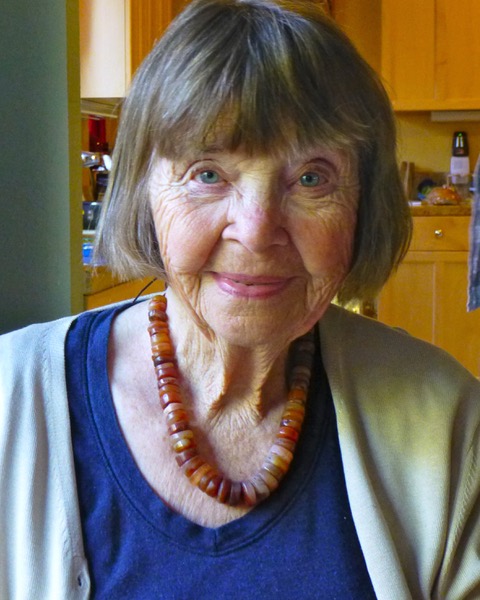
On a Zoom call in early March, Jason Howard shared how activism for the betterment of others had always run in his family. With his mother, it had always been about doing the right thing. Whether it was forging forward in the campaign to bring Women’s Studies to the campus, or making such a meaningful and lasting contact with her students who years later continue to reach out to her, thanking her for the influence she had on them, or the way she brought history to life through the Chautauqua characters she created during her last years at the University and for close to a decade after she retired, Louisa May Alcott, Dorothy Parker and Kate Chopin among them, Jason has always thought his mother’s life was always about making a difference.
It’s been the longest campaign possible, yet always following the same path. Do the committee work. Sweat the details. Write the letters. Then move to action.
So much done. So much still to do.
“I’ve learned from this lady right here,” Jason says, pointing with affection to his 93-year-old mother sitting next to him who – along with many others, she will always tell you – started a Women’s Studies movement on campus. “I’ve learned that she can be very nice about it. But she is always firm, and that’s the key. She will politely ask. And then if someone says no, it’s always been her duty to do more.”
Sources
Anne Howard’s letter to N. Edd Miller: “Defining Moments in Women’s Studies at the University of Nevada, Reno,” by Sheryl Kleinendorst and Jean Ford, 1994.
Anne Howard 1985 interview: “Feminism, politics blend in Anne Howard’s life, book,” Reno Gazette-Journal, June 30, 1985.
Anne Howard writing on Frandsen Humanities: “Memories of Teaching in Frandsen,” Footprints, Winter 2005 issue.
Robert Gorrell Oral History: “University Growing Up: Rambling Reminisces of an English Professor and Admnistrator, 1945-1980,” University of Nevada, Reno Oral History Program.
Max Milam Oral History: “Max Milam: Presidential Memoir, University of Nevada, Reno, 1974-78.”
Rebecca Stafford on being A&S dean and goals: “Dr. Rebecca Stafford: Color her unique,” Reno Evening Gazette, April 17, 1977.
Anne Howard 1979 interview: “Studying women’s contributions to history,” Reno Evening Gazette, Oct. 2, 1979.
Elaine Enarson first Women’s Studies director: “Defining Moments in Women’s Studies at the University of Nevada, Reno,” by Sheryl Kleinendorst and Jean Ford, 1994.
Anne Howard 1986 interview: “UNR Women’s Center celebrates 6th anniversary,” Reno Gazette-Journal, Oct. 17, 1986.
Elaine Enarson 1986 interview: “UNR Women’s Center celebrates 6th anniversary,” Reno Gazette-Journal, Oct. 17, 1986.
Ann Ronald appointment and Crowley reaction: “UNR selects dean for arts and science college,” Reno Gazette-Journal, April 21, 1989.
Jennifer Ring 1997 interview: “Women’s Studies now is offered as a major at UNR,” Reno Gazette-Journal, May 26, 1997.
Ann Howard 1999 Oral History: “Governor’s Day 1970: A Retrospective View”
